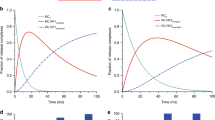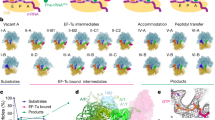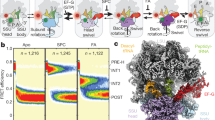Abstract
Although the recognition of stop codons by class 1 release factors (RFs) on the ribosome takes place with extremely high fidelity, the molecular mechanisms behind this remarkable process are poorly understood. Here we performed structural probing experiments with Fe(II)-derivatized RFs to compare the conformations of cognate and near-cognate ribosome termination complexes. The structural differences that we document provide an unprecedented view of how authentic stop-codon recognition is signaled to the large subunit of the ribosome. These events initiate with very close interactions between RF and the small-subunit decoding center, lead to increased interactions between the switch loop of the RF and specific regions of the subunit interface and end in the adoption of the precise orientation of the RF for maximal catalytic activity in the large-subunit peptidyl transferase center.
This is a preview of subscription content, access via your institution
Access options
Subscribe to this journal
Receive 12 print issues and online access
$189.00 per year
only $15.75 per issue
Buy this article
- Purchase on Springer Link
- Instant access to full article PDF
Prices may be subject to local taxes which are calculated during checkout




Similar content being viewed by others
References
Youngman, E.M., McDonald, M.E. & Green, R. Peptide release on the ribosome: mechanism and implications for translational control. Annu. Rev. Microbiol. 62, 353–373 (2008).
Zaher, H.S. & Green, R. Fidelity at the molecular level: lessons from protein synthesis. Cell 136, 746–762 (2009).
Ogle, J.M. & Ramakrishnan, V. Structural insights into translational fidelity. Annu. Rev. Biochem. 74, 129–177 (2005).
Ogle, J.M. et al. Recognition of cognate transfer RNA by the 30S ribosomal subunit. Science 292, 897–902 (2001).
Ogle, J.M., Murphy, F.V., Tarry, M.J. & Ramakrishnan, V. Selection of tRNA by the ribosome requires a transition from an open to a closed form. Cell 111, 721–732 (2002).
Jorgensen, F., Adamski, F.M., Tate, W.P. & Kurland, C.G. Release factor-dependent false stops are infrequent in Escherichia coli. J. Mol. Biol. 230, 41–50 (1993).
Freistroffer, D.V., Kwiatkowski, M., Buckingham, R.H. & Ehrenberg, M. The accuracy of codon recognition by polypeptide release factors. Proc. Natl. Acad. Sci. USA 97, 2046–2051 (2000).
Youngman, E.M., He, S.L., Nikstad, L.J. & Green, R. Stop codon recognition by release factors induces structural rearrangement of the ribosomal decoding center that is productive for peptide release. Mol. Cell 28, 533–543 (2007).
Weixlbaumer, A. et al. Insights into translational termination from the structure of RF2 bound to the ribosome. Science 322, 953–956 (2008).
Laurberg, M. et al. Structural basis for translation termination on the 70S ribosome. Nature 454, 852–857 (2008).
Korostelev, A. et al. Crystal structure of a translation termination complex formed with release factor RF2. Proc. Natl. Acad. Sci. USA 105, 19684–19689 (2008).
Shin, D.H. et al. Structural analyses of peptide release factor 1 from Thermotoga maritima reveal domain flexibility required for its interaction with the ribosome. J. Mol. Biol. 341, 227–239 (2004).
Fraser, C.S., Hershey, J.W. & Doudna, J.A. The pathway of hepatitis C virus mRNA recruitment to the human ribosome. Nat. Struct. Mol. Biol. 16, 397–404 (2009).
Spanggord, R.J., Siu, F., Ke, A. & Doudna, J.A. RNA-mediated interaction between the peptide-binding and GTPase domains of the signal recognition particle. Nat. Struct. Mol. Biol. 12, 1116–1122 (2005).
Wilson, K.S., Ito, K., Noller, H.F. & Nakamura, Y. Functional sites of interaction between release factor RF1 and the ribosome. Nat. Struct. Biol. 7, 866–870 (2000).
Culver, G.M. & Noller, H.F. Directed hydroxyl radical probing of RNA from iron(II) tethered to proteins in ribonucleoprotein complexes. Methods Enzymol. 318, 461–475 (2000).
Moazed, D., Stern, S. & Noller, H.F. Rapid chemical probing of conformation in 16 S ribosomal RNA and 30 S ribosomal subunits using primer extension. J. Mol. Biol. 187, 399–416 (1986).
Ledoux, S. & Uhlenbeck, O.C. [3′-32P]-labeling tRNA with nucleotidyltransferase for assaying aminoacylation and peptide bond formation. Methods 44, 74–80 (2008).
Silverman, J.A. & Harbury, P.B. Rapid mapping of protein structure, interactions, and ligand binding by misincorporation proton-alkyl exchange. J. Biol. Chem. 277, 30968–30975 (2002).
Yusupov, M.M. et al. Crystal structure of the ribosome at 5.5 Å resolution. Science 292, 883–896 (2001).
Ito, K., Uno, M. & Nakamura, Y. A tripeptide 'anticodon' deciphers stop codons in messenger RNA. Nature 403, 680–684 (2000).
Sternberg, S.H., Fei, J., Prywes, N., McGrath, K.A. & Gonzalez, R.L. Jr. Translation factors direct intrinsic ribosome dynamics during translation termination and ribosome recycling. Nat. Struct. Mol. Biol. 16, 861–868 (2009).
Sanbonmatsu, K.Y., Joseph, S. & Tung, C.S. Simulating movement of tRNA into the ribosome during decoding. Proc. Natl. Acad. Sci. USA 102, 15854–15859 (2005).
Freistroffer, D.V., Pavlov, M.Y., MacDougall, J., Buckingham, R.H. & Ehrenberg, M. Release factor RF3 in E. coli accelerates the dissociation of release factors RF1 and RF2 from the ribosome in a GTP-dependent manner. EMBO J. 16, 4126–4133 (1997).
Cannone, J.J. et al. The comparative RNA web (CRW) site: an online database of comparative sequence and structure information for ribosomal, intron, and other RNAs. BMC Bioinformatics 3, 2 (2002).
Moazed, D. & Noller, H.F. Transfer RNA shields specific nucleotides in 16S ribosomal RNA from attack by chemical probes. Cell 47, 985–994 (1986).
Dorner, S., Brunelle, J.L., Sharma, D. & Green, R. The hybrid state of tRNA binding is an authentic translation elongation intermediate. Nat. Struct. Mol. Biol. 13, 234–241 (2006).
Brunelle, J.L., Youngman, E.M., Sharma, D. & Green, R. The interaction between C75 of tRNA and the A loop of the ribosome stimulates peptidyl transferase activity. RNA 12, 33–39 (2006).
Acknowledgements
We thank E. Youngman, H. Zaher, S. Djuranovic and N. Guydosh for comments on the manuscript, the US National Institutes of Health for funding of the project and the Howard Hughes Medical Institute for salary support to R.G.
Author information
Authors and Affiliations
Contributions
S.L.H. and R.G. designed the experiments; S.L.H. performed the experiments; S.L.H. and R.G. discussed results and contributed to the manuscript.
Corresponding author
Ethics declarations
Competing interests
The authors declare no competing financial interests.
Supplementary information
Supplementary Text and Figures
Supplementary Figures 1–6 (PDF 9210 kb)
Rights and permissions
About this article
Cite this article
He, S., Green, R. Visualization of codon-dependent conformational rearrangements during translation termination. Nat Struct Mol Biol 17, 465–470 (2010). https://doi.org/10.1038/nsmb.1766
Received:
Accepted:
Published:
Issue Date:
DOI: https://doi.org/10.1038/nsmb.1766



